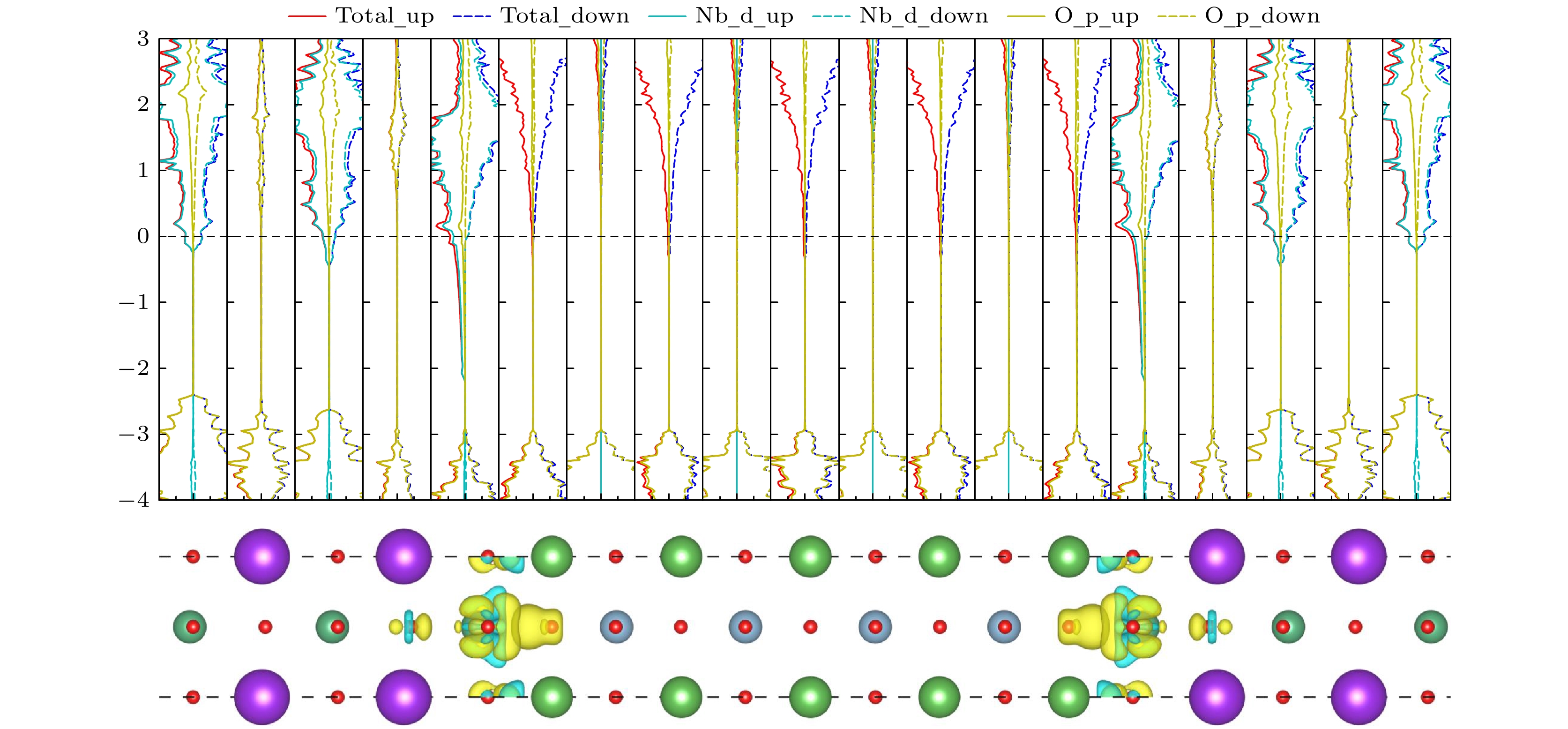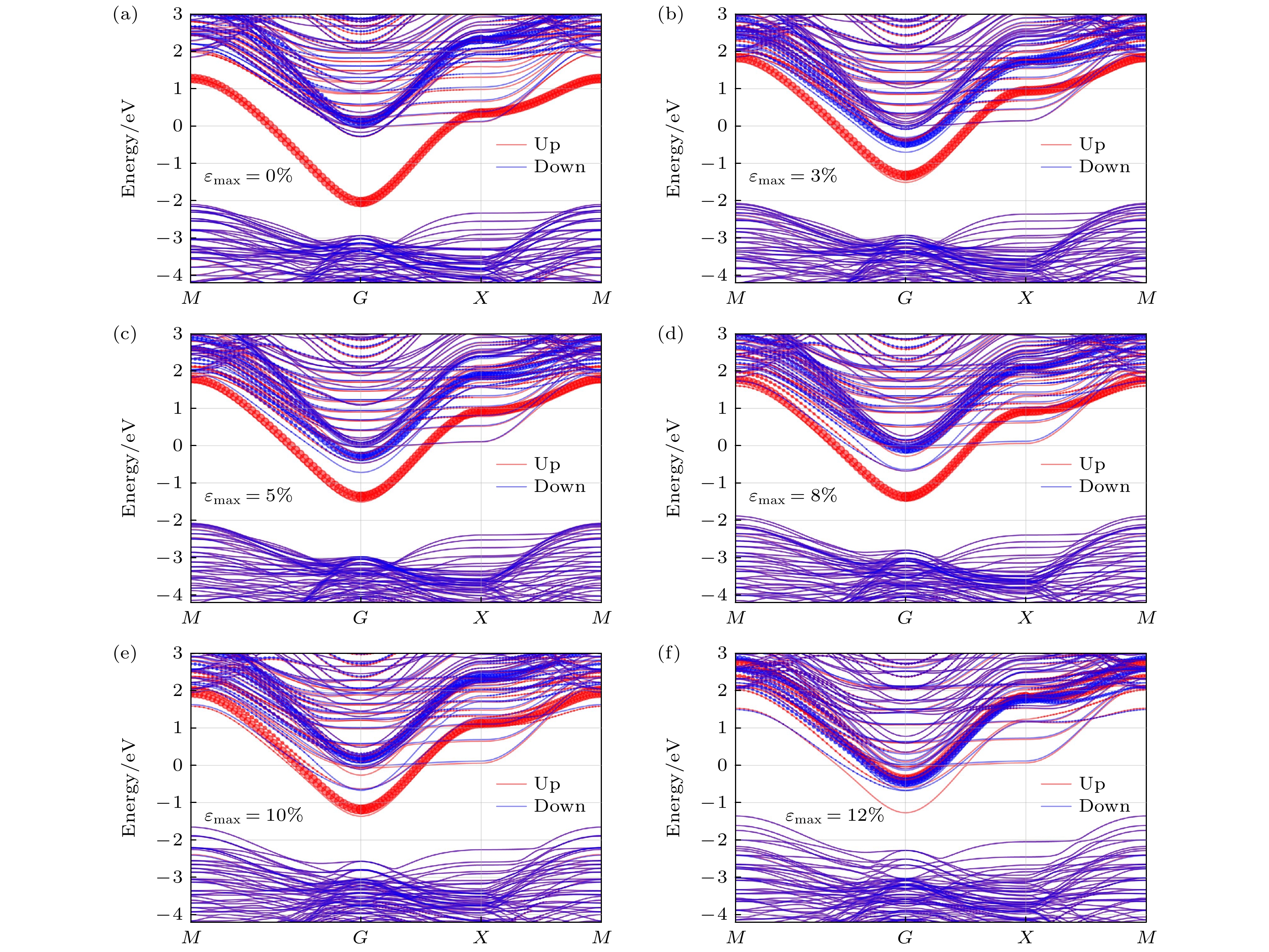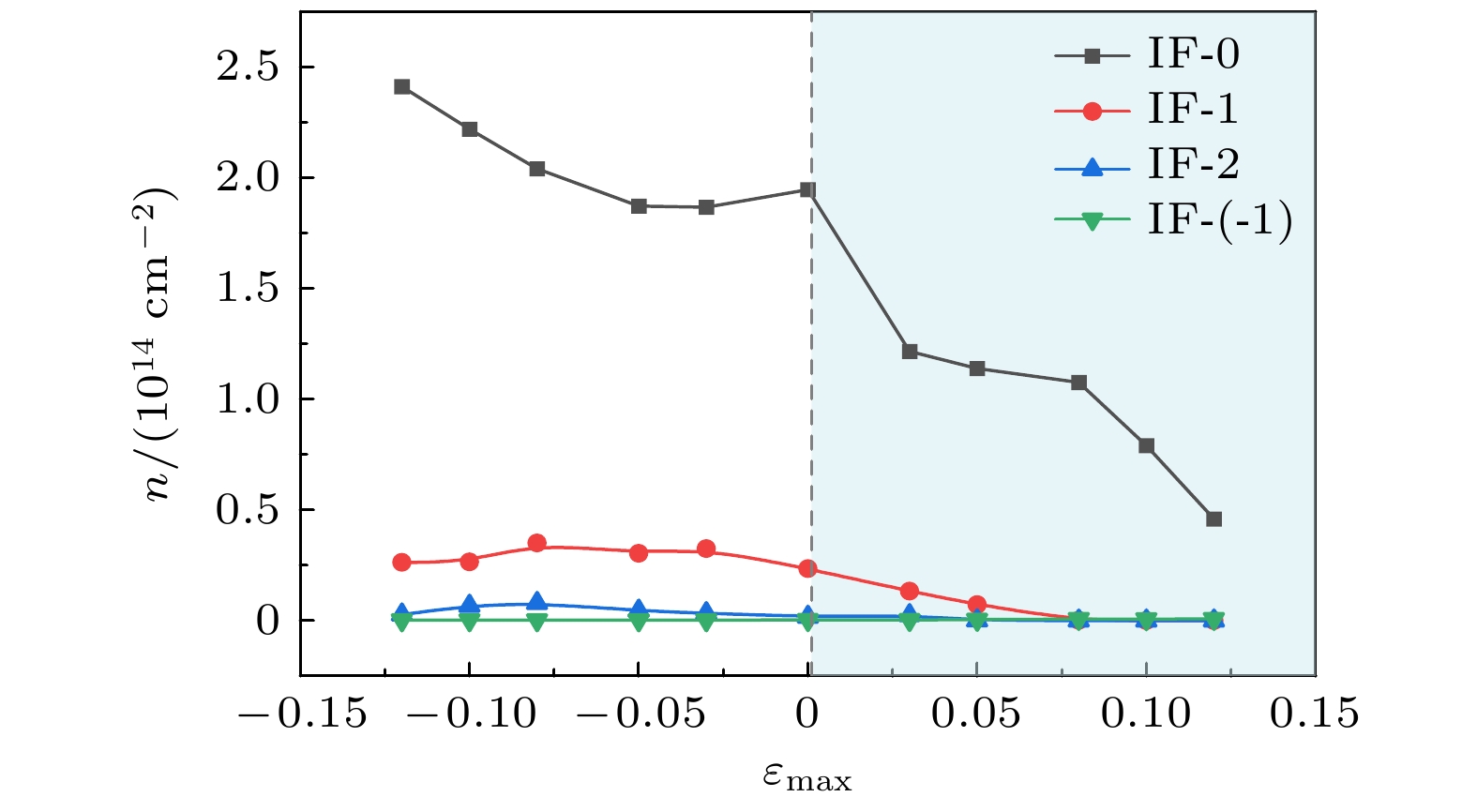-
The superlattices composed of polar/polar perovskites have two-dimensional electron gas (2DEG) at the interface, which has broad applications in nano devices, super sensitive sensor devices, high electron mobility transistor, etc. Tuning the electronic properties of the 2DEG at the interface perovskite superlattice, such as the coupling between strain gradient and the electronic properties of the 2DEG in correlated electronic systems, is of great significance. In this paper, the properties of (LaAlO3)4.5/(KNbO3)8.5 superlattice, which is composed of KNbO3 and LaAlO3, are systematically investigated through first-principles density functional theory calculations. The band structure of (LaAlO3)4.5/(KNbO3)8.5 superlattice exhibits 2DEG at the interface, which is consistent with the result in the literature. The band structure, density of states, magnetic moments and carrier concentration at the interface are fully investigated by using compressive gradient and tensile strain gradient, respectively. The results show that compressive strain gradient can effectively reduce the 2DEG concentration at the interface. When the compressive strain gradient coefficient reaches 12%, the 2DEG concentration decreases by 76.4%, and the interface magnetic moment disappears. The total magnetic moment of the superlattice decreases by 88.44%. When the tensile strain gradient is 12%, the electron gas concentration at the interface is increased by about 23.9%, and the interface magnetic moment is reduced by about 90.7%. At the same time, an obvious magnetic moment appears in the layer near the interface. Hence, the strain gradient can be a new approach to regulating the electron gas concentration at interface of perovskite superlattice. The tensile strain gradient increases the electron gas concentration at the interface, while the compressive strain gradient reduces the electron gas concentration. Therefore, it opens up a new way to exploring the regulation of high-performance spin polarized carrier gas at the oxide interface.
-
Keywords:
- strain gradient /
- two-dimensional electron gas /
- superlattice /
- first principles
[1] Tra V T, Chen J W, Huang P C, et al. 2013 Adv. Mater. 25 3357
 Google Scholar
Google Scholar
[2] Thiel S, Hammerl G, Schmehl A, Schneider C W, Mannhart J 2006 Science 313 1942
 Google Scholar
Google Scholar
[3] Reyren N, Thiel S, Caviglia A D, et al. 2007 Science 317 1196
 Google Scholar
Google Scholar
[4] Caviglia A D, Gariglio S, Reyren N, et al. 2008 Nature 456 624
 Google Scholar
Google Scholar
[5] Bi F, Huang M, Ryu S, Lee H, Bark C W, Eom C B, Irvin P, Levy J 2014 Nat. Commun. 5 5019
 Google Scholar
Google Scholar
[6] 李敏, 时鑫娜, 张泽霖, 吉彦达, 樊济宇, 杨浩 2019 物理学报 68 087302
 Google Scholar
Google Scholar
Li M, Shi X N, Zhang Z L, Ji Y D, Fan J Y, Yang H 2019 Acta Phys. Sin. 68 087302
 Google Scholar
Google Scholar
[7] Bert J A, Kalisky B, Bell C, Kim M, Hikita Y, Hwang H Y, Moler K A 2011 Nat. Phys. 7 767
 Google Scholar
Google Scholar
[8] 朱立峰, 潘文远, 谢燕, 张波萍, 尹阳, 赵高磊 2019 物理学报 68 217701
 Google Scholar
Google Scholar
Zhu L F, Pan W Y, Xie Y, Zhang B P, Yin Y, Zhao G L 2019 Acta Phys. Sin. 68 217701
 Google Scholar
Google Scholar
[9] Sharma P, Huang Z, Li M, Li C, Hu S, Lee H, Lee J W, Eom C B, Pennycook S J, Seidel J, Ariando, Gruverman A 2018 Adv. Funct. Mater. 28 1707159
 Google Scholar
Google Scholar
[10] Baikie T, Fang Y, Kadro J M, Schreyer M, Wei F, Mhaisalkar S G, Graetzel M, White T J 2013 J. Mater. Chem. A 1 5628
 Google Scholar
Google Scholar
[11] Phillips L J, Rashed A M, Treharne R E, et al. 2016 Sol. Energy Mater. Sol. Cells 147 327
 Google Scholar
Google Scholar
[12] Stranks S D, Eperon G E, Grancini G, et al. 2013 Science 342 341
 Google Scholar
Google Scholar
[13] Zhao Y, Nardes A M, Zhu K 2014 J. Phys. Chem. Lett. 5 490
 Google Scholar
Google Scholar
[14] Ponseca C S, Savenije T J, Abdellah M, et al. 2014 J. Am. Chem. Soc. 136 5189
 Google Scholar
Google Scholar
[15] Brinkman A, Huijben M, Van Zalk M, et al. 2007 Nat. Mater. 6 493
 Google Scholar
Google Scholar
[16] Kalisky B, Bert J A, Bell C, Xie Y, Sato H K, Hosoda M, Hikita Y, Hwang H Y, Moler K A 2012 Nano Lett. 12 4055
 Google Scholar
Google Scholar
[17] Dikin D A, Mehta M, Bark C W, Folkman C M, Eom C B, Chandrasekhar V 2011 Phys. Rev. Lett. 107 056802
 Google Scholar
Google Scholar
[18] Guduru V K, del Aguila A G, Wenderich S, et al. 2013 Appl. Phys. Lett. 102 051604
 Google Scholar
Google Scholar
[19] Lei Y, Li Y, Chen Y Z, Xie Y W, Chen Y S, Wang S H, Wang J, Shen B G, Pryds N, Hwang H Y, Sun J R 2014 Nat. Commun. 5 5554
 Google Scholar
Google Scholar
[20] Au K, Li D F, Chan N Y, Dai J Y 2012 Adv. Mater. 24 2598
 Google Scholar
Google Scholar
[21] Bark C W, Felker D A, Wang Y, et al. 2011 Proc. Natl. Acad. Sci. U.S.A. 108 4720
 Google Scholar
Google Scholar
[22] Salluzzo M, Gariglio S, Stornaiuolo D, et al. 2013 Phys. Rev. Lett. 111 087204
 Google Scholar
Google Scholar
[23] Schoofs F, Carpenter M A, Vickers M E, et al. 2013 J. Phys. Condes. Matter 25 175005
 Google Scholar
Google Scholar
[24] Huang Z, Liu Z Q, Yang M, et al. 2014 Phys. Rev. B 90 125156
 Google Scholar
Google Scholar
[25] Du Y, Wang C, Li J, Zhang X, Wang F, Zhu Y, Yin N, Mei L 2015 Comput. Mater. Sci. 99 57
 Google Scholar
Google Scholar
[26] Meevasana W, King P D C, He R H, Mo S K, Hashimoto M, Tamai A, Songsiriritthigul P, Baumberger F, Shen Z X 2011 Nat. Mater. 10 114
 Google Scholar
Google Scholar
[27] Fang L, Chen C, Yang Y, Wu Y, Hu T, Zhao G, Zhu Q, Ren W 2019 Phys. Chem. Chem. Phys. 21 8046
 Google Scholar
Google Scholar
[28] Zhang Z, Jiang W, Liu K, Liu M, Meng J, Wu L, Shao T, Ling J, Yao C, Xiong C, Dou R, Nie J 2020 Ann. Phys. Berlin 532 2000155
 Google Scholar
Google Scholar
[29] Cooper V R 2012 Phys. Rev. B 85 235109
 Google Scholar
Google Scholar
[30] Pentcheva R, Pickett W E 2008 Phys. Rev. B 78 205106
 Google Scholar
Google Scholar
[31] Shu L, Wei X, Jin L, Li Y, Wang H, Yao X 2013 Appl. Phys. Lett. 102 152904
 Google Scholar
Google Scholar
[32] Nystrom M J, Wessels B W, Chen J, Marks T J 1996 Appl. Phys. Lett. 68 761
 Google Scholar
Google Scholar
-
图 1 (a) (LaAlO3)4.5/(KNbO3)8.5晶胞模型; (b)压缩非均匀应变原子偏移示意图; (c)拉伸非均匀应变原子偏移示意图, 箭头大小表示偏离平衡位置的程度
Figure 1. (a) The (LAO)4.5/(KNO)8.5 superlattice model; (b) schematic diagram of atomic shift in compressed non-uniform strain; (c) schematic diagram of atomic migration under non-uniform tensile strain. Arrow size indicates the degree of deviation from the balance position.
图 3 不同最大压缩应变梯度系数下NbO2/LaO界面层及其附近的态密度 (a)
$\varepsilon_{\max} $ = 0%; (b)$\varepsilon_{\max} $ = 3%; (c)$\varepsilon_{\max} $ = 5%; (d)$\varepsilon_{\max} $ = 8%; (e)$\varepsilon_{\max} $ = 10%; (f)$\varepsilon_{\max} $ = 12%Figure 3. Density of state of NbO2/LaO interface layer and its adjacent layer under different maximum compressive strain gradients coefficient: (a)
$\varepsilon_{\max} $ = 0%; (b)$\varepsilon_{\max} $ = 3%; (c)$\varepsilon_{\max} $ = 5%; (d)$\varepsilon_{\max} $ = 8%; (e)$\varepsilon_{\max} $ = 10%; (f)$\varepsilon_{\max} $ = 12%.图 4 不同最大压缩应变梯度系数下LAO/KNO的能带图及界面Nb元素dxy的轨道投影能带 (a)
$\varepsilon_{\max} $ = 0%; (b)$\varepsilon_{\max} $ = 3%; (c)$\varepsilon_{\max} $ = 5%; (d)$\varepsilon_{\max} $ = 8%; (e)$\varepsilon_{\max} $ = 10%; (f)$\varepsilon_{\max} $ = 12%Figure 4. The band structures of LAO/KNO and projected band structures of interface with orbit of Nb element dxy under different maximum compressive strain gradient coefficient: (a)
$\varepsilon_{\max} $ = 0%; (b)$ \varepsilon_{\max}$ = 3%; (c)$\varepsilon_{\max} $ = 5%; (d)$\varepsilon_{\max} $ = 8%; (e)$\varepsilon_{\max} $ = 10%; (f)$\varepsilon_{\max} $ = 12%.图 5 不同最大拉伸应变梯度系数下NbO2/LaO界面层及其附近的态密度 (a)
$\varepsilon_{\max} $ = 0%; (b)$\varepsilon_{\max} $ =3%; (c)$\varepsilon_{\max} $ = 5%; (d)$\varepsilon_{\max} $ = 8%; (e)$\varepsilon_{\max} $ = 10%; (f)$\varepsilon_{\max} $ =12%Figure 5. Density of state of NbO2/LaO interface layer and its adjacent layer under different maximum tensile strain gradient coefficient: (a)
$\varepsilon_{\max} $ = 0%; (b)$\varepsilon_{\max} $ = 3%; (c)$\varepsilon_{\max} $ = 5%; (d)$\varepsilon_{\max} $ = 8%; (e)$\varepsilon_{\max} $ = 10%; (f)$\varepsilon_{\max} $ = 12%.图 6 不同最大拉伸应变梯度系数下LAO/KNO的能带图及界面Nb元素的dxy轨道的投影能带 (a)
$\varepsilon_{\max} $ = 3%; (b)$\varepsilon_{\max} $ = 5%; (c)$\varepsilon_{\max} $ = 8%; (d)$\varepsilon_{\max} $ = 10%Figure 6. The band structures of LAO/KNO and projected band structures of interface with orbit of Nb element dxy under different maximum tensile strain gradient coefficient: (a)
$\varepsilon_{\max} $ = 3 %; (b)$\varepsilon_{\max} $ = 5%; (c)$\varepsilon_{\max} $ = 8%; (d)$\varepsilon_{\max} $ = 10%. -
[1] Tra V T, Chen J W, Huang P C, et al. 2013 Adv. Mater. 25 3357
 Google Scholar
Google Scholar
[2] Thiel S, Hammerl G, Schmehl A, Schneider C W, Mannhart J 2006 Science 313 1942
 Google Scholar
Google Scholar
[3] Reyren N, Thiel S, Caviglia A D, et al. 2007 Science 317 1196
 Google Scholar
Google Scholar
[4] Caviglia A D, Gariglio S, Reyren N, et al. 2008 Nature 456 624
 Google Scholar
Google Scholar
[5] Bi F, Huang M, Ryu S, Lee H, Bark C W, Eom C B, Irvin P, Levy J 2014 Nat. Commun. 5 5019
 Google Scholar
Google Scholar
[6] 李敏, 时鑫娜, 张泽霖, 吉彦达, 樊济宇, 杨浩 2019 物理学报 68 087302
 Google Scholar
Google Scholar
Li M, Shi X N, Zhang Z L, Ji Y D, Fan J Y, Yang H 2019 Acta Phys. Sin. 68 087302
 Google Scholar
Google Scholar
[7] Bert J A, Kalisky B, Bell C, Kim M, Hikita Y, Hwang H Y, Moler K A 2011 Nat. Phys. 7 767
 Google Scholar
Google Scholar
[8] 朱立峰, 潘文远, 谢燕, 张波萍, 尹阳, 赵高磊 2019 物理学报 68 217701
 Google Scholar
Google Scholar
Zhu L F, Pan W Y, Xie Y, Zhang B P, Yin Y, Zhao G L 2019 Acta Phys. Sin. 68 217701
 Google Scholar
Google Scholar
[9] Sharma P, Huang Z, Li M, Li C, Hu S, Lee H, Lee J W, Eom C B, Pennycook S J, Seidel J, Ariando, Gruverman A 2018 Adv. Funct. Mater. 28 1707159
 Google Scholar
Google Scholar
[10] Baikie T, Fang Y, Kadro J M, Schreyer M, Wei F, Mhaisalkar S G, Graetzel M, White T J 2013 J. Mater. Chem. A 1 5628
 Google Scholar
Google Scholar
[11] Phillips L J, Rashed A M, Treharne R E, et al. 2016 Sol. Energy Mater. Sol. Cells 147 327
 Google Scholar
Google Scholar
[12] Stranks S D, Eperon G E, Grancini G, et al. 2013 Science 342 341
 Google Scholar
Google Scholar
[13] Zhao Y, Nardes A M, Zhu K 2014 J. Phys. Chem. Lett. 5 490
 Google Scholar
Google Scholar
[14] Ponseca C S, Savenije T J, Abdellah M, et al. 2014 J. Am. Chem. Soc. 136 5189
 Google Scholar
Google Scholar
[15] Brinkman A, Huijben M, Van Zalk M, et al. 2007 Nat. Mater. 6 493
 Google Scholar
Google Scholar
[16] Kalisky B, Bert J A, Bell C, Xie Y, Sato H K, Hosoda M, Hikita Y, Hwang H Y, Moler K A 2012 Nano Lett. 12 4055
 Google Scholar
Google Scholar
[17] Dikin D A, Mehta M, Bark C W, Folkman C M, Eom C B, Chandrasekhar V 2011 Phys. Rev. Lett. 107 056802
 Google Scholar
Google Scholar
[18] Guduru V K, del Aguila A G, Wenderich S, et al. 2013 Appl. Phys. Lett. 102 051604
 Google Scholar
Google Scholar
[19] Lei Y, Li Y, Chen Y Z, Xie Y W, Chen Y S, Wang S H, Wang J, Shen B G, Pryds N, Hwang H Y, Sun J R 2014 Nat. Commun. 5 5554
 Google Scholar
Google Scholar
[20] Au K, Li D F, Chan N Y, Dai J Y 2012 Adv. Mater. 24 2598
 Google Scholar
Google Scholar
[21] Bark C W, Felker D A, Wang Y, et al. 2011 Proc. Natl. Acad. Sci. U.S.A. 108 4720
 Google Scholar
Google Scholar
[22] Salluzzo M, Gariglio S, Stornaiuolo D, et al. 2013 Phys. Rev. Lett. 111 087204
 Google Scholar
Google Scholar
[23] Schoofs F, Carpenter M A, Vickers M E, et al. 2013 J. Phys. Condes. Matter 25 175005
 Google Scholar
Google Scholar
[24] Huang Z, Liu Z Q, Yang M, et al. 2014 Phys. Rev. B 90 125156
 Google Scholar
Google Scholar
[25] Du Y, Wang C, Li J, Zhang X, Wang F, Zhu Y, Yin N, Mei L 2015 Comput. Mater. Sci. 99 57
 Google Scholar
Google Scholar
[26] Meevasana W, King P D C, He R H, Mo S K, Hashimoto M, Tamai A, Songsiriritthigul P, Baumberger F, Shen Z X 2011 Nat. Mater. 10 114
 Google Scholar
Google Scholar
[27] Fang L, Chen C, Yang Y, Wu Y, Hu T, Zhao G, Zhu Q, Ren W 2019 Phys. Chem. Chem. Phys. 21 8046
 Google Scholar
Google Scholar
[28] Zhang Z, Jiang W, Liu K, Liu M, Meng J, Wu L, Shao T, Ling J, Yao C, Xiong C, Dou R, Nie J 2020 Ann. Phys. Berlin 532 2000155
 Google Scholar
Google Scholar
[29] Cooper V R 2012 Phys. Rev. B 85 235109
 Google Scholar
Google Scholar
[30] Pentcheva R, Pickett W E 2008 Phys. Rev. B 78 205106
 Google Scholar
Google Scholar
[31] Shu L, Wei X, Jin L, Li Y, Wang H, Yao X 2013 Appl. Phys. Lett. 102 152904
 Google Scholar
Google Scholar
[32] Nystrom M J, Wessels B W, Chen J, Marks T J 1996 Appl. Phys. Lett. 68 761
 Google Scholar
Google Scholar
Catalog
Metrics
- Abstract views: 5942
- PDF Downloads: 368
- Cited By: 0















 DownLoad:
DownLoad:



















































